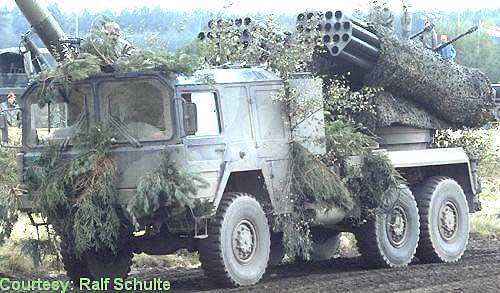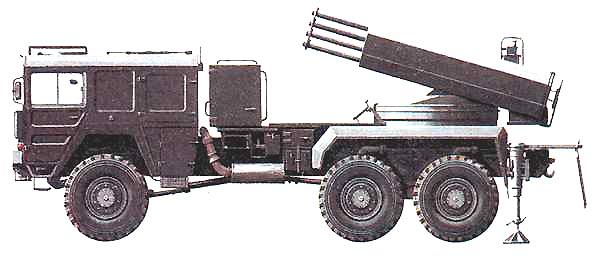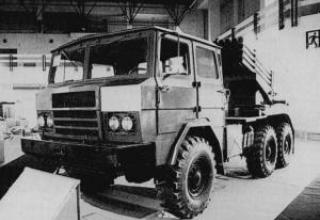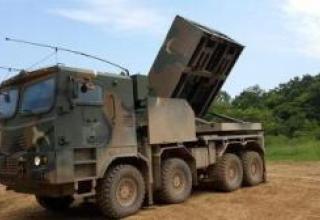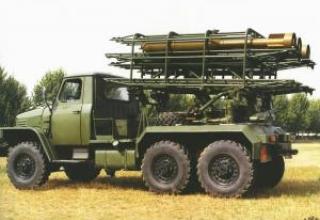Lars-2" (Leichtes Artillerie-Raketen-System) multiple launch rocket system is designed to destroy advanced calculations of military equipment, dispersed enemy manpower, artillery calculations and remote landmining.
The "Lars-2" system is the result of the modernization program of the LARS-1 RSF, adopted by the Bundeswehr in 1969. From 1980 to 1983 in accordance with this program all 209 LARS-1 launchers in service with the Bundeswehr were upgraded.
A wide range of ammunition, including projectiles and submunitions with shrapnel, fragmentation and smoke effects, mines for antitank and antipersonnel landmines provide the capability to engage targets of different types - manpower, armoured vehicles, fortifications and army control points.
The plans of the Bundeswehr Command provide for the gradual replacement of these installations with MLRS systems. Removable LARS-2 units are handed over to the armed forces of Greece and Turkey.
Composition:
Upgrading primarily affected the launcher. The wheel chassis of the outdated truck "Magirus-Deutz" has been replaced by the chassis of the high cross-country vehicle MAN, in a multi-cab with the calculation and fire control equipment. The engine is diesel MAN with an output of 260 hp. The chassis is made on the wheel arrangement bhb and is equipped with a centralized system of air pressure regulation in tires.
The artillery part, which is two armored packages with 18 barrels each, is mounted on a platform of circular rotation above the rear axles of the chassis. In the vertical plane, the missiles can be aimed at a target in the range of angles from 0° to +50°. The pointing is performed by a gunner, whose position is between the barrel packs. Stability of the launcher during firing is provided by two hydraulic jacks, on which the aft part of the chassis is hung when the launcher is moved to the combat position.
The LARS-1 can be fired with 110mm unguided projectiles (NUR), included in the LARS-1 rocket launcher, as well as with advanced NUR with a range of up to 25 km, for which new head units have been developed:
- cassette DM-711, equipped with five AT-2 anti-tank mines. The mines are ejected from the cassette chamber chamber at a height of approximately 1.2km and lowered by parachutes. Just before landing, the parachute is separated and the landed mine is placed in its combat position using spring-loaded legs - a cumulative funnel upwards. The pin sensor is pulled out of the housing. Self-liquidation time of the mine is set before firing and can be from several hours to several days. Cumulative charge of the mine is capable of piercing through the armour up to 140 mm thick.
- The smoke screen contains 8.4 kg of smoke-forming mixture, which increased the resistance of the smoke screen from 12 to 15 minutes.
- cassette HF with 65 American-made M42 or M77 cumulative shrapnel elements. It is designed to defeat open-mounted manpower and military equipment, lightly armored combat vehicles, as well as for counter-battery combat. Each combat element has a solid shrapnel hit radius of up to 3-4m and is capable of penetrating armor up to 40mm thick.
The LARS-2 is equipped with the advanced FIELD GUARD fire control system, which enables the gun to shoot a repeater and automatically detect the necessary corrections for multiple fire. The FIELD GUARD system includes a radar for tracking missile trajectories and computers. One system serves four LARS-2 PU. Currently, a new version of this system is available - FIELD GUARD Mk2, which has a higher fire performance.
The launcher is also equipped with REPAG equipment, designed to check missiles, set the time of fuse activation of the combat unit and select the mode of missile launch.
The launcher can overcome hills up to 30°, has good cross-country ability. It can ford 1.2 m deep without prior preparation. The equipment includes radio communication facilities, navigation equipment and firefighting equipment.
Characteristics:
| Caliber,mm | 110 |
| Number of guides | 36 |
| Calculation, man. | 3 |
| Weight in combat position, t | 17,48 |
| Overall dimensions, mm | |
| Length | 8280 |
| Width | 2500 |
| Height in hiking position | 2990 |
| Weight of projectile, kg | 34 |
| Range of fire, km | |
| Minimum, km | 6,5 |
| Maximum | 14,7 - 25,0 |
| The duration of the volley, s | 18 |
| Recharging time, min | 15-20 |
| Engine power, l. s. | 260 |
| Maximum speed, km/h | 80 |
| Power reserve, km | 500 |
Testing:
The first flight test of the XMG-M52C "Lance" rocket with extended range was conducted at White Sands Range on March 6, 1969. The first series of missiles entered the army for military trials in April 1971. The first launch took place in August 1972, and in March 1972 the military trials were fully completed.
In May 1972, the missile system "Lance" was officially recognized as a protocol model of military equipment and was classified as a class "Standard A". However, only a Lance missile with a nuclear warhead was included in this class, as Congress had not yet approved the development of a cluster bomb head unit, which the command of the ground forces considered necessary to have in service.
Immediately after the approval of the missile, the delivery of the Lance missile system to NATO partners and Israel began. Six divisions were formed in Europe. Two of them were in Germany, which could not but bother the USSR Armed Forces group "Center": the flight time of the Lance missile is only about 200 seconds, so there was no way to quickly detect and shoot down the missile. Missiles equipped with non-nuclear head units were delivered to Israel.
There are reports that the Lance missile system was used by U.S. forces during the war in Afghanistan in the late 70's and early 80's.
In the mid-80s, the Lance missile system was withdrawn from service due to the nuclear arms reduction treaty between the USSR and the United States. Currently, the Lance missile is used as a target for anti-missile testing. There is evidence that it is used in the development of the US national missile defense program.
Sources:
- В.Н. Шунков "Ракетное оружие" (ООО"Попури" 2001г)
- М.Регентов "Реактивные системы залпового огня" (Зарубежное военное обозрение N2 1987г)
- Leichtes Artillerie Raketensystem 2 (BW)
- 110-mm Multiple Launch Rocket System LARS - 2
- SUBMUNITIONS
